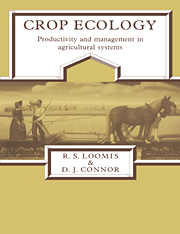Book contents
- Frontmatter
- Contents
- Preface
- Part I Farming systems and their biological components
- Part II Physical and chemical environments
- Part III Production processes
- Part IV Resource management
- 12 Soil management and sustainability
- 13 Strategies and tactics for rainfed agriculture
- 14 Water management in irrigated agriculture
- 15 Energy and labor
- 16 Analysis of wheat–sheep farming in southern Australia
- 17 Mixed farming in the North American Corn Belt
- 18 Towards an uncertain future
- References
- Species list
- Conversions and constants useful in crop ecology
- Index
13 - Strategies and tactics for rainfed agriculture
from Part IV - Resource management
Published online by Cambridge University Press: 05 June 2012
- Frontmatter
- Contents
- Preface
- Part I Farming systems and their biological components
- Part II Physical and chemical environments
- Part III Production processes
- Part IV Resource management
- 12 Soil management and sustainability
- 13 Strategies and tactics for rainfed agriculture
- 14 Water management in irrigated agriculture
- 15 Energy and labor
- 16 Analysis of wheat–sheep farming in southern Australia
- 17 Mixed farming in the North American Corn Belt
- 18 Towards an uncertain future
- References
- Species list
- Conversions and constants useful in crop ecology
- Index
Summary
INTRODUCTION
Most agriculture is practised under rainfed conditions with varying supplies of water, in some cases including local additions by surface flow and seepage. Farming strategies and tactics divide roughly into those aimed towards coping with too much water and those for coping with too little. This chapter concentrates on the management of water for rainfed agriculture in dry regions because a greater diversity of methods have been developed for those conditions and because the relations between production and water supply are seen there most clearly. Chapter 14 examines the principles of irrigation as a separate topic. We begin first, however, with brief comments on management of farming in wet regions where the hazards and the methods employed to counter them are rather different from those in dry regions.
AGRICULTURE OF WET REGIONS
Rainfed agriculture in humid regions would seem to have a blessing of a free good in its water supply. That supply is seldom ideal, however, varying from excess to transient deficiency. Excess supply leading to surface flooding and saturated soils is a major problem that generally requires drainage works (Section 12.5). Water erosion (Section 12.6) and nutrient loss are also greater concerns with abundant rainfall than in drier regions. Leaching of nitrogen was considered in Chapter 8. The importance of vegetative cover in controlling erosion and nutrient losses dictates that many sloping sites be maintained in pasture.
- Type
- Chapter
- Information
- Crop EcologyProductivity and Management in Agricultural Systems, pp. 349 - 377Publisher: Cambridge University PressPrint publication year: 1992



